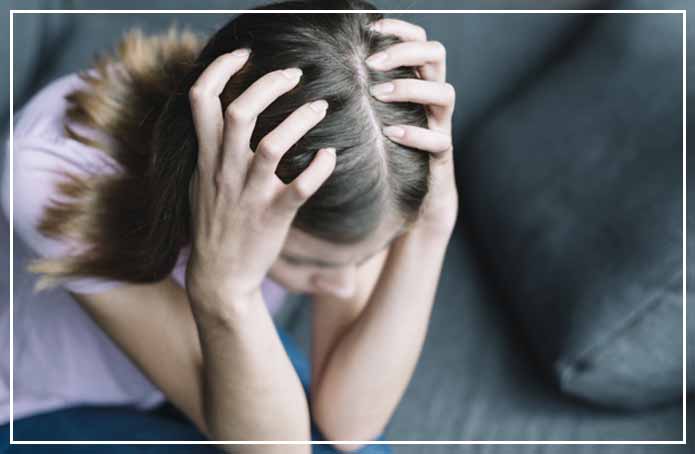Very often, we have heard people complaining about headaches, which is very normal in this stress full conditions prevailing around each one. It has got many reasons but the main reason is an imbalance of diet and exercises. One has to keep the system of their brain very cool and active which can be very easily done by adopting a good lifestyle. Now talking about chronic migraine, a normal headache cannot be chronic migraine but yes all migraines are headaches.
A chronic migraine causes severe hurting pain or a beating sensation, very often on one side of the head. The after-effects of the chronic migraine could be nausea, vomiting, and extreme sensitivity to light and sound. Migraine attacks can precede for hours to days, and the pain is intolerable and interferes with our daily activities.
It has also been observed that some people come across an aura problem before or with the headache. Aura refers to visual disturbances such as flashes of light or blind spots showing tingling on one side of the face or in an arm or leg and difficulty in speaking.
Medications do work to prevent some migraines and make them less painful. The right medicines, along with self-help remedies and lifestyle changes, will definitely help a lot.
Symptoms
Chronic migraines, when gets initiated in childhood or adolescence or early adulthood, usually progress through four stages: prodrome, aura, attack and post-drome. It is not necessary that everyone who has migraines has to go through all stages, but varies with the weakness of a person.
Prodrome
In this, a patient gets a warning a day or two before the migraine. The symptoms could be:
- Constipation
- Mood changes, from depression to euphoria
- Food cravings
- Neck stiffness
- Increased thirst and urination
- Frequent yawning
Aura
Some people experience an aura which might occur before or during chronic migraines. The reversible symptoms of the nervous system are an aura. Mostly visual disturbances and lasts for 20 to 60 minutes.
The appearance could be:
- Visualizing various shapes, bright spots or flashes of light.
- Vision loss
- pricking sensations in an arm or leg
- Feeling too low, numbness in the face or one side of the body
- Difficulty in speaking
- Hearing some noises or music
- Body appears shaking
Attack
A chronic migraine generally stays from 4 to 72 hours without medication. But its frequency varies from person to person. It can also occur rarely or strike several times a month.
During the attack one can sense the following:
- One side of the headaches is worse.
- Pain has the beating effect or throbbing
- A patient becomes very much sensitive to light, noise, and sometimes smell and also touch
- Nausea and vomiting
Post-drome
A chronic migraine attack after the lapse period leaves behind a person drained out of energy, confused and lost for the whole day. The rapid head movement might cause pain again for a short time.
Causes
Though the causes of chronic migraine are not very clear, could be genetic and moreover environmental factors appear to play a lead role.
Scientifically the changes in the brainstem and its interactions with the nerves create a major pain pathway. Other neurotransmitters calcitonin, gene-related peptide (CGRP) along with serotonin plays a major role in the pain of migraine.
Chronic migraine triggers
There could be any of the factors responsible for migraine:
- Hormonal changes: Chronic migraine symptoms usually get aggravated in women during menstruation, due to changing hormone levels.
- Behavioral Changes: Any sudden change in emotional factors like stress, depression, anxiety, excitement, and shock can also trigger a migraine.
- Physical stress: Fatigue and less sleep, cervical, poor posture, and physical overexertion could also result in chronic low blood sugar and jet lag can also trigger a migraine.
- Imbalance diet: People taking alcohol and caffeine can contribute to migraines. Some specific foods like chocolate, cheese, citrus fruits, and foods containing the additive tyramine may also cause chronic Skipping meals and dehydration have also been named as potential triggers.
- Under some medications: Sleeping pills, steroids, and the contraceptive pills have also seen responsible for chronic
- Environmental changes: Some of the environmental conditions like strong smells, cigarette smoke, and loud noises can also cause migraine. Suffocated rooms, change in temperatures, and very bright lights also trigger chronic
Treatment
Currently, there is no perfect treatment for migraines. But some of the factors described below could promote improvement in the adverse conditions and slowly a person might get transformed to normal.
Alterations in lifestyle are very important, this will definitely help in reducing the frequency of migraines:
- Proper and sound sleep
- Reduction in stress
- Consuming plenty of water
- Intoxicating food items, alcohols, rich food should be avoided
- Morning walk, exercises, pranayama and meditation are highly effective.
- Some people find that natural and uncooked diets can help a lot.
“If the above remedy does not work then one should consult the doctor but the treatment of chronic migraines with medicines can never be productive. Be patient and work more on a change of lifestyle and diet”.

























